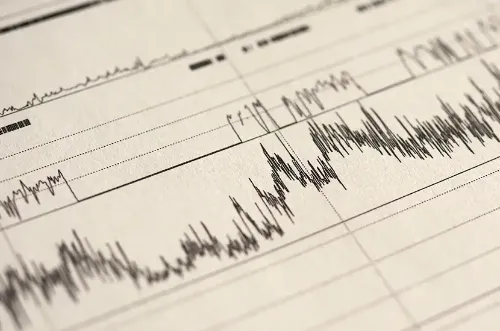Sleep disorders
"Sleeping well is not easy. There are many sleep disorders, many of them little known. For that reason, the treatment of the upheavals of the dream must be supervised by a specialist to obtain the maximum therapeutic benefit and to minimize the risk of adverse effects".
DR. ARANTZA CAMPO EZQUIBELA
SPECIALIST. SLEEP UNIT

What are sleep disorders?
Sleep disorders are not a serious pathology in themselves, but they do have serious implications in daily life: physical exhaustion, low performance, daytime sleepiness, difficulty in meeting professional, family or social obligations...
These disorders are: insomnia, hypersomnia, narcolepsy, snoring and sleep apneas, parasomnias and other disorders, restless leg syndrome, night terrors, nightmares and sleepwalking
Its origin is very varied. Sometimes, they appear as an effect of other diseases and sometimes, they constitute risk factors that favor the appearance of other pathologies.
For this reason, the correct diagnosis and treatment of these patients requires a multidisciplinary approach, such as that offered by the Sleep Unit of the Clínica Universidad de Navarra. For their diagnosis, a polysomnography or sleep test is performed, which consists of the recording during the night of the physiological variables.

What are the symptoms of sleep disorders?
Some of the symptoms that produce sleep disorders are: physical exhaustion, low performance, daytime sleep, difficulty in meeting professional, family or social obligations, etc.
When there are different upheavals, there are specific symptoms of each one.
- Restless legs: uncomfortable and painful parestesias (sensation of tingling) in the interior of the legs, spontaneous and uncontrollable movements.
- Somnambulism: walking in a semi-conscious sleep mode.
- Night terrors: episodes of terror with screaming and agitation, sometimes accompanied by sleepwalking.
- Insomnia: difficulty in falling asleep, nighttime awakening or premature end of sleep.
- Hypersomnia: increases habitual sleep by 25%.
- Narcolepsy: repeated sleep crises during wakefulness.
- Snoring and sleep apneas: obstruction of the pharynx that does not let air pass.
The most common symptoms are:
- Impossibility to sleep
- Waking up early
- Physical exhaustion
- Low performance
- Daytime Sleep
- Difficulty in fulfilling professional, family or social obligations, etc.
Do you have any of these symptoms?
You may have a sleep disorder
What are the causes?
There are more than 100 types of sleep disorders, of very varied origin.
Sometimes, the upheavals of the dream appear like effect of other diseases and constitute factors of risk for the appearance of other pathologies.
- In the case of the insomnia, the anxiety, the hyperthyroidism, the psychiatric diseases or those that produce pain are their more common causes.
- In the hypersomnia, the causes can be associated to anxiety or serious depression, abuse of hypnotics or apnea of the dream.
- For its part, snoring is produced by the temporary mechanical obstruction of the upper airways, more frequent in men from 40 years, especially if they suffer from obesity. In many cases it is accompanied by obstructive sleep apneas.
- In the case of narcolepsy, the cause can be a chronic hypersomnia at an early age.
- The bruxism is due to the emotional stress and the occlusal interferences.
- Restless legs can be caused by iron deficiency anemia, chronic kidney failure, diabetes mellitus or Parkinson's disease.
- Also some drugs such as sedatives, antihistamines, neuroleptics or antidepressants can aggravate the symptoms.
¿Cuáles son las fases del sueño?
The sleep pattern is not uniform, but has several distinct phases:
- Phase1-N1. Numbness, the transition between wakefulness and sleep, occurs.
- Phase2-N2. Sleep is light. The heart and respiratory rate decrease.
- Phase3. This is the phase of transition to deep sleep.
- Phase4. The degree of depth is greater and it is very difficult to wake up.
- REM-R phase. In which there are rapid eye movements and greater brain activity. This phase increases during the second half of the night.
How are sleep disorders diagnosed?

The correct diagnosis and treatment of patients with sleep disorders requires an approach from different medical specialties, which are integrated into the Sleep Unit.
For its correct diagnosis, it is necessary to perform a polysomnography or sleep test with simultaneous video recording that consists of recording during the night the physiological variables such as the electroencephalogram, nasal flow, oxygen saturation and heart rate. It allows to know the structure of the patient's sleep and to catalogue his disorder.
How are sleep problems treated?
The Clínica Universidad de Navarra has a Sleep Unit which is made up of a multidisciplinary group of specialists and auxiliary personnel from the departments related to sleep: Otorhinolaryngology, Endocrinology, Pneumology, Neurology, Neurophysiology, Pediatrics, Psychiatry and Check-ups.
With proper diagnosis and management by a multidisciplinary team, sleep disorders have a high percentage of cure.
The Unit is coordinated by the Neurophysiology service, in charge of the polysomnographic studies or sleep test, which consists of the recording during the night of physiological variables such as the electroencephalogram, nasal flow, oxygen saturation and heart frequency, among others.
Where do we treat them?
IN NAVARRA AND MADRID
The Sleep Unit
of the Clínica Universidad de Navarra
Accredited by the Spanish Sleep Society, the Clinic's Sleep Unit has the latest advances in diagnosis and treatment of sleep disorders.
The joint work of the different medical and surgical disciplines that integrate the Unit of the Sleep of the Clinica does that every patient can be attended approaching his problem of global form, collaborating, if it is necessary, for different specialists.
Diseases we treat

Why at the Clinica?
- We have the best facilities to perform sleep studies.
- Nursing specialized in these disorders for their care and follow up.
- State-of-the-art technology and a highly specialized team.

















